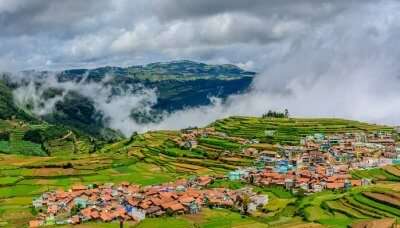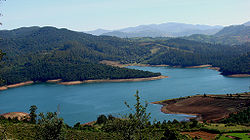Originally occupied by the Toda people, the area came under the rule of the East India Company at the end of the 18th century. The economy is based on tourism and agriculture, along with the manufacture of medicines and photographic film. The town is connected by the Nilgiri ghat roads and Nilgiri Mountain Railway. Its natural environment attracts tourists and it is a popular summer destination.In 2011, the town had a population of 88,430.
The origin of the name is obscure. The first known written mention of the place is given as Wotokymund in a lett.er of March 1821 to the Madras Gazette from an unknown correspondent. In early times it was called Ottakal Mandu. The name probably changed under British rule from Udagamandalam to Ootacamund, and later was shortened to Ooty.
The first part of the name (Ootaca) is probably a corruption of the local name for the central region of the Nilgiri Plateau.Otha-Cal literally means "single stone". This is perhaps a reference to a sacred stone revered by the local Toda people.
"Mund" is the Anglicised form of the Toda word for a village, Mandu.
Ooty is in the Nilgiri hills, meaning the "blue mountains", so named due to the Kurunji flower which blooms every twelve years giving the slopes a bluish tinge.
Udagamandalam was originally a tribal land occupied by the Toda along with other hill tribes who coexisted through specialisation and trade. The major tribes of Nilgiris area are the Toda, Kota, Irula and Kurumba.
The Toda in the Nilgiris are first referenced in a record belonging to Hoysala king Vishnuvardhana and his general Punisa, dated 1117 CE. The Toda people were known for raising water buffalo. The people known for farming activities.Nilgiris was ruled by various dynasties.
like Satavahanas, Gangas, Kadambas, Rashtrakutas, Hoysalas, the Vijayanagara empire and the Rajas of Ummattur (on behalf of Wodeyars of Mysuru).Tipu Sultan captured Nilgiris in the eighteenth century and extended the border by constructing a hideout cave-like structure.[ The Nilgiris came into possession of British East India Company as part of the ceded lands, held by Tipu Sultan, by the treaty of Srirangapatnam in 1799.
In 1818, J. C. Whish and N. W. Kindersley, assistants to John Sullivan, then Collector of Coimbatore, visited Ooty and submitted a report to him. Sullivan camped at Dimbhatti, north of Kotagiri in January 1819 and was enthralled by the beauty of the place. He wrote to Thomas Munro, " ... it resembles Switzerland, more than any country of Europe... the hills beautifully wooded and fine strong spring with running water in every valley." The Toda ceded that part of the town to Sullivan and in May 1819, he began to build his bungalow at Dimbhatti. He also started work on a road from Sirumugai to Dimbhatti that year. The road was completed in May 1823, and extended up to Coonoor by 1830–32.





Post a Comment